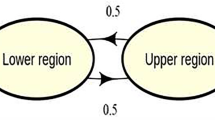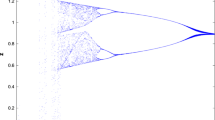Abstract
Characterizing organism growth within populations requires the application of well-studied individual size-at-age models, such as the deterministic Gompertz model, to populations of individuals whose characteristics, corresponding to model parameters, may be highly variable. A natural approach is to assign probability distributions to one or more model parameters. In some contexts, size-at-age data may be absent due to difficulties in ageing individuals, but size-increment data may instead be available (e.g., from tag-recapture experiments). A preliminary transformation to a size-increment model is then required. Gompertz models developed along the above lines have recently been applied to strongly heterogeneous abalone tag-recapture data. Although useful in modelling the early growth stages, these models yield size-increment distributions that allow negative growth, which is inappropriate in the case of mollusc shells and other accumulated biological structures (e.g., vertebrae) where growth is irreversible.
Here we develop probabilistic Gompertz models where this difficulty is resolved by conditioning parameter distributions on size, allowing application to irreversible growth data. In the case of abalone growth, introduction of a growth-limiting biological length scale is then shown to yield realistic length-increment distributions.
Similar content being viewed by others
References
Bardos, D.C., Day, R.W., Lawson, N.T., Linacre, N.A., 2004. Abalone population responses to fishing in multi-stage models with various density dependencies (submitted for publication).
Day, R.W., Fleming, A.E., 1992. In: Shepherd, S.A., Tegner, M.J., Guzmán del Próo, S.A. (Eds.), Abalone of the World: Biology, Fisheries, and Culture. Oxford Fishing News Books, Cambridge, MA, pp. 141–168.
Fabens, A.J., 1965. Properties and fitting of the von Bertalanffy growth curve. Growth 29, 265–289.
Gilks, W.R., Richardson, S., Spiegelhalter, D.J., 1996. Markov Chain Monte Carlo in Practice. Chapman & Hall, London.
Gompertz, B., 1825. On the nature of the function expressive of the law of human mortality, and on a new mode of determining the value of life contingencies. Philos. Trans. R. Soc. 115, 513–585.
Jeffreys, H.S., 1939. Theory of Probability. The Clarendon Press, Oxford.
Jolicoeur, P., Cabana, T., Ducharme, G., 1992a. A four-parameter generalization of the Gompertz curve suitable for somatic growth. Growth Dev. Aging 56, 69–74.
Jolicoeur, P., Pontier, J., Abidi, H., 1992b. Asymptotic models for the longitudinal growth of human stature. Am. J. Hum. Biol. 4, 461–468.
Kaufmann, K.W., 1981. Fitting and using growth curves. Oecologia (Berlin) 49, 293–299.
Palmer, M.J., Phillips, B.F., Smith, G.T., 1991. Application of nonlinear models with random coefficients to growth data. Biometrics 47, 623–636.
Sainsbury, K.J., 1980. Effect of individual variability on the von Bertalanffy growth equation. Can. J. Fish. Aquat. Sci. 37, 241–247.
Sainsbury, K.J., 1982. Population dynamics and fishery management of the paua, Haliotis iris. II. Dynamics and management examined using a size class population model. N.Z. J. Mar. Freshw. Res. 16, 163–173.
Troynikov, V.S., 1998. Probability density functions useful for parametrization of heterogeneity in growth and allometry data. Bull. Math. Biol. 60, 1099–1121.
Troynikov, V.S., Gorfine, H.K., 1998. Alternative approach for establishing legal minimum lengths for abalone based on stochastic growth models for length-increment data. J. Shellfish Res. 17, 827–831.
Troynikov, V.S., Day, R.W., Leorke, A.M., 1998. Estimation of seasonal growth parameters using a stochastic Gompertz model for tagging data. J. Shellfish Res. 17, 833–838.
von Bertalanffy, L., 1938. A quantitative theory of organic growth (inquiries on growth laws II). Hum. Biol. 10, 181–213.
Yamaguchi, M., 1975. Estimating growth parameters from growth rate data: problems with marine sedentary invertebrates. Oecologia (Berlin) 20, 321–332.
Author information
Authors and Affiliations
Rights and permissions
About this article
Cite this article
Bardos, D.C. Probabilistic Gompertz model of irreversible growth. Bull. Math. Biol. 67, 529–545 (2005). https://doi.org/10.1016/j.bulm.2004.08.009
Received:
Accepted:
Issue Date:
DOI: https://doi.org/10.1016/j.bulm.2004.08.009




